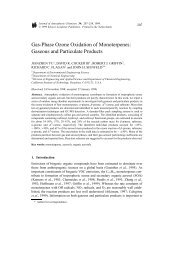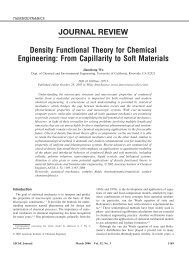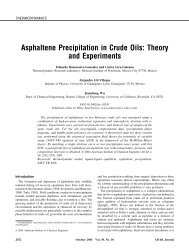DEVELOPMENT OF REVISED SAPRC AROMATICS MECHANISMS
DEVELOPMENT OF REVISED SAPRC AROMATICS MECHANISMS
DEVELOPMENT OF REVISED SAPRC AROMATICS MECHANISMS
You also want an ePaper? Increase the reach of your titles
YUMPU automatically turns print PDFs into web optimized ePapers that Google loves.
Several revisions were made to make the mechanism more consistent with recent literature data:<br />
Most of the revisions concerned aromatics, but an error was corrected in the temperature dependence for<br />
the reaction of OH radicals with acetylene, a few updates were made to the base mechanism concerning<br />
reactions of HO 2 with acetyl peroxy radicals (RC(O)O 2·). Correcting the acetylene error does not affect<br />
predictions at ambient temperatures and the update to the HO 2 + acetyl peroxy reactions only affects<br />
product and radical predictions under low NO x conditions and predictions of O 3 formation. The<br />
mechanism for glyoxal, an important aromatic oxidation product was also updated. The rate constants and<br />
yields of known oxidation products from the reactions of the aromatic hydrocarbons that are separately<br />
represented in the mechanism were updated to be consistent with current literature data. But the major<br />
changes concerned revisions made to improve model simulations of O 3 formation in aromatic - NO x<br />
environmental chamber experiments. The quantum yields for radical formation from the model species<br />
representing unknown aromatic ring-opening products were adjusted to remove biases in model<br />
simulations of NO oxidation and O 3 formation rates in aromatic - NO x experiments with NO x levels lower<br />
than ~100 ppb. New mechanisms were derived for the reactions of the oxidation products phenol, cresols,<br />
and xylenols to improve model simulations of experiments with those compounds.<br />
A second version of <strong>SAPRC</strong>-11, designated <strong>SAPRC</strong>-11A was developed in an attempt to account<br />
for an apparent dependence of mechanism evaluation results on total NO x levels for certain compounds.<br />
This is the same as <strong>SAPRC</strong>-11 except that the possibility that adducts formed after OH radical addition to<br />
the aromatic ring may react with NO 2 to form less reactive compounds is considered.<br />
The updated aromatics mechanisms were developed and evaluated by conducting model<br />
simulations of results of 410 aromatic - NO x environmental chamber experiments carried out in 9<br />
different environmental chambers at three different laboratories using five different types of light sources.<br />
Approximately half were new experiments not used when developing <strong>SAPRC</strong>-07, including data at lower<br />
NO x levels more representative of ambient conditions and with new compounds, including phenolic<br />
products, that have not been experimentally studied previously. Many of these new experiments were<br />
carried out for the purpose of studying SOA formation from aromatics, but the data are suitable for gasphase<br />
mechanism evaluation as well.<br />
This mechanism was used as the starting point for the development of a mechanism for predicting<br />
aromatic SOA formation as discussed in a separate report (Carter et al, 2012). This involved adding<br />
model species and reactions for predicting SOA, but that did not affect gas-phase predictions. A<br />
discussion of this is beyond the scope of the present report, which focuses only on gas-phase predictions.<br />
Results<br />
The most significant finding is that it is not possible for the model to simulate the rates of NO<br />
oxidation and O 3 formation over the full range of available NO x conditions for some important aromatic<br />
compounds without adding additional NO x -dependent processes that were not previously considered in<br />
aromatics mechanisms used in airshed models. In order to simulate the data over the full range of NO x<br />
conditions for these compounds it is necessary to assume that the OH-aromatic adduct formed from<br />
compounds reacts with O 2 sufficiently slowly that reaction of the adduct with NO 2 can become<br />
competitive at the NO x levels in the higher NO x experiments, forming less reactive products. However,<br />
this is not consistent with laboratory data and with known dependences of aromatic product yields on NO x<br />
levels. Therefore, either there is an inconsistency between the chamber data and the published laboratory<br />
results, or there is a different, unknown, process that causes this additional NO x dependence in the<br />
chamber experiments. This is applicable to benzene, toluene, ethylbenzene and p-xylene, but not to o- or<br />
m-xylene, the trimethylbenzenes and (probably) o-cresol. The data are not sufficient to determine whether<br />
it is applicable to the compounds studied.<br />
2
















